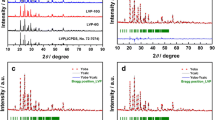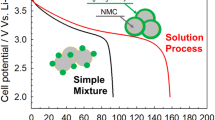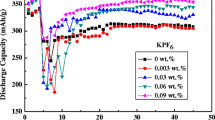Abstract
A Li7P2S8I solid electrolyte was prepared by the reaction between raw materials in an ethyl propionate medium and drying of the precursor. The obtained sample was characterized by X-ray diffraction (XRD), cyclic voltammetry, DC polarization test and AC impedance measurements. The formation of Li7P2S8I was confirmed from the results of XRD. Cyclic voltammetry and the DC polarization test indicated that the obtained Li7P2S8I was stable at low potential versus Li/Li+ and against Li metal. The all-solid-state lithium-ion battery was fabricated by using Li–In, Li7P2S8I solid electrolyte and a graphite composite that was prepared by mixing graphite, Li7P2S8I solid electrolyte and vapor grown carbon fiber with a vortex mixer. It was observed that the electrode materials were homogeneously mixed from the scanning electron microscopy image of the composite prepared by using the vortex mixer. The fabricated half-cell was characterized by the charge–discharge test. The Li7P2S8I solid electrolyte is suitable for use with a graphite anode because the charge–discharge test exhibited an initial discharge capacity of 372 mA h g−1 and high reversibility of capacity.
Graphical Abstract

Similar content being viewed by others
Avoid common mistakes on your manuscript.
1 Introduction
All-solid-state lithium-ion batteries (ASSLiBs) with inflammable solid electrolytes (SEs) have been extensively studied because they are capable of working at high temperature, compared with conventional lithium-ion batteries that use liquid electrolytes. In addition, ASSLiBs are expected to have higher energy density and power density by increasing the active materials of the electrodes and using SEs which have a wide electrochemical window. However, SEs with an ionic conductivity no higher than 10−3 S cm−1 are currently available for ASSLiBs. Sulfide-based SEs have been a focus all over the world because they show unique mechanical properties and high ionic conductivity; in particular, the Li10GeP2S12 SE has an ionic conductivity higher than 10−3 S cm−1, which is almost similar to liquid organic electrolytes [1, 2]. Meanwhile, it is well known that the addition of LiI into sulfide-based SEs, such as Li3PS4 (LPS), will increase its ionic conductivity [3,4,5].
In general, sulfide-based SEs are synthesized by the mechanochemical ball-milling technique or melt-quenching method, which have many advantages for preparing new materials, but many problems also arise for their large-scale production because of the high energy requirement. In our laboratory, sulfide-based SEs, such as LPS and Li7P3S11, have successfully been prepared by the liquid phase method since the reaction between raw materials can be promoted in organic solvents such as ethyl propionate or tetrahydrofuran [4, 6]. The liquid phase method is able to synthesize SEs at room temperature more quickly than the solid phase methods. In addition, the preparation of Li2S–P2S5–LiI SE by the liquid phase method has not been reported in detail.
Graphite is a negative active material, which has a large theoretical capacity of 372 mA h g−1 and a low potential at 55 mV versus Li/Li+. However, the research of ASSLiBs with a graphite anode has not proceeded because of the requirement of a low-potential stability of the SEs. However, it was reported that Li2S–P2S5–LiI SEs are stable at 0 V versus Li/Li+, which makes Li2S–P2S5–LiI SE a candidate for application in ASSLiB with a graphite anode [7].
The focus of this work is on the preparation of the Li7P2S8I (LPSI) SE, which is a kind of Li2S–P2S5–LiI SE, by using the liquid phase method and its application in an all-solid-state half-cell with graphite. The precursor of the SE was prepared by mixing the raw materials with ZrO2 balls in ethyl propionate. The suspension thus prepared was evacuated under low pressure to obtain the SE. The obtained SE was characterized by X-ray diffraction (XRD), cyclic voltammetry, DC polarization test and impedance measurements. The half-cell with a graphite anode was fabricated with the Li–In alloy, LPSI SE and the composite, which consisted of graphite powder, SE and vapor grown carbon fiber (VGCF). The obtained half-cell was characterized by the charge–discharge tests. The formation of LPSI was confirmed by using XRD and it showed an ionic conductivity of 3 × 10−4 S cm−1 at room temperature. In addition, the obtained LPSI exhibited a wide electrochemical window from 10 to 0 V versus Li/Li+ and was suitable for application in ASSLiB with a graphite anode.
2 Experimental
A suspension of the SE precursor was prepared by the liquid-phase shaking method as reported in our previous study [8]. Li2S (Mitsuwa, 99.9%), P2S5 (Merck, 99%) and LiI (Aldrich, 99.9%), as raw materials at the molar ratio of 3:1:1 (0.3827 g, 0.617 g and 0.3717 g, respectively), were mixed with 4-mm zirconia balls (about 32 g) and ethyl propionate (10 mL; Aldrich) in a 45-mL centrifugation tube (polypropylene, Labcon). The suspension was obtained by shaking under a dry Ar atmosphere at 1500 rpm for 6 h. The obtained suspension was evacuated at room temperature, 50 °C and 170 °C for 2 h under low pressure using a rotary vacuum pump in an Ar atmosphere to obtain the SE.
The structure characterization of the prepared sample was conducted by using XRD (Ultima IV, Rigaku). The sample was protected from exposure to air humidity by using special holders.
The temperature dependence of the ionic conductivity of the prepared sample was investigated by using alternating-current impedance spectroscopy (SI 1260, Solartron) from 1 MHz to 10 Hz. The sample for measuring the ionic conductivity was prepared by uniaxial cold pressing approximately 80 mg of the sample into a pellet (diameter of 10.0 mm, thickness of approximately 0.60 mm) at a pressure of 510 MPa. The obtained pellet was put in poly ether ether ketone (PEEK) holder and sandwiched between stainless steel (SUS) electrodes to fabricate the cell for impedance measurements. The temperature was gradually increased from room temperature to 130 °C, while each temperature was held for 1 h prior to measurement.
Cyclic voltammetry was conducted by using a potentiostat (SI 1287, Solartron). The cell was prepared by attaching lithium foil (diameter of 9 mm, thickness of approximately 0.1 mm) to one face of the pelletized sample and sandwiching it between the SUS electrodes. Then the prepared SUS | Li | SE | SUS cell was tested at a scan of 5 mV s−1 between − 0.3 and 10 V.
The DC polarization test was performed by using a charge–discharge device (BST-2004H, Nagano) with a Li | SE | Li symmetric cell. The cell was prepared by attaching lithium foil on both sides of the pelletized SE. The test was carried out with a current density of ± 0.1 mA cm−1.
The negative electrode composite was prepared by mixing graphite (SFG-15, TIMCAL), LPSI SE and VGCF as the conductive additive (each weight ratio was 50 wt%, 50 wt% and 3 wt%) with 1-mm zirconia balls (about 12 g) in a 45-mL centrifugation tube with a vortex mixer at 4800 rpm for 15 min (shaking).
The all-solid-state half-cell with a graphite anode was fabricated with the Li–In alloy, SE and the composite. To prepare the cell, the bilayer pellet (diameter of 10 mm), composed of the electrode composite (10 mg) and the SE (80 mg), was obtained by cold pressing at 200 MPa; then indium and lithium foils were attached on the opposite sides of the SE. After that, the cell was prepared by sandwiching the pellet between SUS electrodes. The cut-off voltages were 1.0 and − 0.62 V versus Li–In at 0.05 C. The cell was kept at 60 °C ± 1 °C for 2 h prior to being tested.
3 Results and Discussion
Figure 1 shows the XRD patterns of the obtained sample dried at 170 °C, LPS, which was prepared by the same method without LiI addition, and the starting materials as the reference. The peaks attributed to the starting materials and LPS were not observed, but new peaks attributed to LPSI crystalline were detected in the XRD patterns of the obtained sample [4]. This observation proved that the reaction among the starting materials was complete after the shaking and drying processes. It has been reported that the LiI solution and LPS precursor, which was prepared by reaction between Li2S and P2S5 in ethyl propionate medium, were obtained after the shaking process, then LPSI was formed by the reaction occurring during the drying process, in which LiI inserted into the structure of LPS at the same time as co-crystalline ethyl propionate contained in the LPS precursor was eliminated [11]. In this study, we propose that the similar reaction steps occurred during the preparation process.
Figure 2 shows the temperature dependence of the ionic conductivities of the prepared LPSI and LPS. The obtained LPSI exhibited an ionic conductivity of 3.8 × 10−4 S cm−1 at room temperature with activation energy of 26 kJ mol−1. In comparison with LPS, the ionic conductivity was two times higher and the activation energy was decreased. Therefore, the addition of LiI into the LPS resulted in an improvement of the ionic conductivity of the obtained sample in this study. Conductivities and activated energy of some sulfide electrolytes were summarized in Table 1. Though it is still lack of evidence, it seems that conductivity and activated energy of sulfide based solid electrolytes are strongly depended on the solvents employed in preparation process.
Figure 3a shows the cyclic voltammogram of the obtained LPSI using a Li | LPSI | SUS cell, in which Li and SUS were the reference and counter electrode, respectively. None of the other peaks were observed from 10 V to − 0.3 V except for the anodic and cathodic peaks of Li. It was considered that LPSI has the wide electrochemical window and is stable at 0 V versus Li/Li+ from this result. Meanwhile, the inset shows a magnification of the low voltage region. As shown in the inset, a reduction current flowed from around 1.5 V for the first scan, but the current was not observed for the second scan. It was suggested that the interface between the SE and Li metal was being formed during first scan and the formation had already finished after the first scan. In addition, the interface was stable for Li metal because the reduction current nearly disappeared for the second scan. Zhu et al. [15] studied the intrinsic electrochemical window of Lithium solid electrolyte materials using DFT calculation and predicted the reduction of Li7P2S8I starting from 1.71 V versus Li+/Li. Their result suggested that Li2S, P and LiI would be the products formed from reduction of LPSI. In practical, XRD result illustrated that LPSI was reduced at about 1.71 V versus Li+/Li to form Li3P, Li5P, Li2S and LiI [8]. In addition, Swamy et al. [16] employed XPS to study the chemical nature of the interface between β-Li3PS4 and Li metal. Their results revealed that the reduction of Li3PS4 in the voltage range from 1.71 to 1.0 V versus Li+/Li led to the formation of Li2S and P; whilst, Li3P and Li2S were the products of the reduction of Li3PS4 in the voltage range from 1.0 to 0.0 V versus Li+/Li. The results observed by Swamy et al. [16] also closed the gap between the practical result studied by Phuc et al. [8] and the theoretical study of Zhu et al. [15]. Figure 3b shows the result of the DC polarization test of the obtained LPSI. The voltage remained constant over 30 cycles. From these results of cyclic voltammetry and DC polarization test, it was suggested that the obtained LPSI is a suitable SE for the cell using Li metal and graphite because LPSI is not decomposed at low potential and the interface formed on the SE has good stability against Li metal for a long time.
Figure 4a–d shows the scanning electron microscopy (SEM) images of LPSI prepared by the liquid-phase shaking method, graphite particles, the composite prepared by shaking with graphite, LPSI and VGCF in a vortex mixer, and the EDX mapping of the composite, respectively. The particle sizes of sulfide-based SEs prepared by the liquid phase method usually tend to be big, up to more than 5 µm [9, 10]. As shown in Fig. 4a, the obtained LPSI particles appeared to have an uncertain morphology with diameters of 1–5 µm. Meanwhile, it was found that the morphology of the graphite particle was flake-like. As shown in Fig. 4c, d, graphite particles, SE particles and VGCF were homogeneously mixed by using the lab mixer.
Figure 5 shows the charge–discharge curves of the half-cell with graphite composites prepared by hand mixing and shaking. The initial discharge capacity of the cell using the composite prepared by shaking was 372 mA h g−1 higher than the second discharge capacity. The second charge capacity of the cell using the composites prepared by hand-mixing decreased dramatically from the first charge capacity, but the reduction of the second charge capacity was suppressed by using the shaking method. It was suggested that more Li+ conductive paths were formed and Li+ was better inserted to graphite in the cell using the composite prepared by shaking because of the better contacts between graphite and SE in the composite. Thus, LPSI SE is suitable for a graphite anode, but we need to determine better ways to prepare graphite composite that has more Li+ conductive paths.
4 Conclusion
The Li7P2S8I solid electrolyte was prepared by reaction of raw materials in ethyl propionate and drying the precursor in vacuum. Crystalline Li7P2S8I was observed from the XRD patterns of the obtained sample. It was observed that the solid electrolyte exhibited a good stability against Li metal from the results of cyclic voltammetry and the DC polarization test. The all-solid-state lithium-ion battery was fabricated by using Li–In, Li7P2S8I and a graphite composite prepared by mixing graphite, Li7P2S8I and VGCF with a vortex mixer. The Li7P2S8I solid electrolyte was suitable for a graphite anode because the charge–discharge test exhibited an initial discharge capacity of 372 mA h g−1 and high reversibility of the capacity.
References
Bachman, J.C., Muy, S., Grimaud, A., Chang, H.H., Pour, N., Lux, S.F., Paschos, O., Maglia, F., Lupart, S., Lamp, P., Giordano, L., Shao-Horn, Y.: Inorganic solid-state electrolytes for lithium batteries: mechanisms and properties governing ion conduction. Chem. Rev. 116, 140–162 (2016)
Kato, Y., Hori, S., Saito, T., Suzuki, K., Hirayama, M., Mitsui, A., Yonemura, M., Iba, H., Kanno, R.: High-power all-solid-state batteries using sulfide superionic conductors. Nat. Energy 1, 16030 (2016)
Kennedy, J.H., Yang, Y.: Glass-forming region and structure in SiS2–Li2S–LiX (X = Br, I). J. Solid State Chem. 69, 252–257 (1987)
Rangasamy, E., Liu, Z., Gobet, M., Pilar, K., Sahu, G., Zhou, W., Wu, H., Greenbaum, S., Liang, C.: An iodide-based Li7P2S8I superionic conductor. J. Am. Chem. Soc. 137, 1384–1387 (2015)
Suyama, M., Kato, A., Sakuda, A., Hayashi, A., Tatsumisago, M.: Lithium dissolution/deposition behavior with Li3PS4–LiI electrolyte for all-solid-state batteries operating at high temperatures. Electrochem. Acta 286, 158–162 (2018)
Phuc, N.H.H., Morikawa, K., Totani, M., Muto, H., Matsuda, A.: Synthesis of plate-like Li3PS4 solid electrolyte via liquid-phase shaking for all-solid-state lithium batteries. Ionics 23, 2061–2067 (2017)
Takada, K., Inada, T., Kajiyama, A., Sasaki, H., Kondo, S., Watanabe, M., Murayama, M., Kanno, R.: Solid-state lithium battery with graphite anode. Solid State Ion. 158, 269–274 (2003)
Phuc, N.H.H., Hirahara, E., Morikawa, K., Muto, H., Matsuda, A.: One-pot liquid phase synthesis of (100 − x) Li3PS4–xLiI solid electrolytes. J. Power Source 365, 7–11 (2017)
Ito, S., Nakakita, M., Aihara, Y., Uehara, T., Machida, N.: A synthesis of crystalline Li7P3S11 solid electrolyte from 1,2-dimethoxyethane solvent. J. Power Source 271, 342–345 (2014)
Liu, Z., Fu, W., Payzant, E.A., Yu, X., Wu, Z., Dudney, N.J., Kiggans, J., Hong, K., Rondinone, A.J., Liang, C.: Anomalous high ionic conductivity of nanoporous β-Li3PS4. J. Am. Chem. Soc. 135, 975–978 (2013)
Phuc, N.H.H., Yamamoto, T., Muto, H., Matsuda, A.: Fast synthesis of Li2S–P2S5–LiI solid electrolyte precursors. Inorg. Chem. Front. 4, 1660–1664 (2017)
Wang, H., Hood, Z.D., Xia, Y., Liang, C.: Fabrication of ultrathin solid electrolyte membranes of β-Li3PS4 nanoflakes by evaporation-induced self-assembly for all-solid-state batteries. J. Mater. Chem. A 4, 8091–8096 (2016)
Phuc, N.H.H., Morikawa, K., Totani, M., Muto, H., Matsuda, A.: Preparation of Li3PS4 solid electrolyte using ethyl acetate as synthetic medium. Solid State Ion. 288, 240–243 (2016)
Wang, Y., Liu, Z., Zhu, X., Tang, Y., Huang, F.: Highly lithium-ion conductive thio-LISICON thin film processed by low-temperature solution method. J. Power Sources 224, 225–229 (2013)
Zhu, Y., He, X., Mo, Y.: Origin of outstanding stability in the lithium solid electrolyte materials: insights from thermodynamic analyses based on first principles calculations. ACS Appl. Mater. Interfaces 7, 23685–23693 (2015)
Swamy, T., Chen, X., Chiang, Y.-M.: Electrochemical redox behavior of Li ion conducting sulfide solid electrolytes. Chem. Mater. 31, 707–713 (2019)
Acknowledgements
This study was supported by the Advanced Low Carbon Technology Specially Promoted Research for Innovative Next Generation Batteries (JST-ALCA-SPRING) program of the Japan Science and Technology Agency. We thank Edanz Group (www.edanzediting.com/ac) for editing a draft of this manuscript.
Author information
Authors and Affiliations
Corresponding authors
Additional information
Publisher's Note
Springer Nature remains neutral with regard to jurisdictional claims in published maps and institutional affiliations.
Rights and permissions
About this article
Cite this article
Yamamoto, T., Phuc, N.H.H., Muto, H. et al. Preparation of Li7P2S8I Solid Electrolyte and Its Application in All-Solid-State Lithium-Ion Batteries with Graphite Anode. Electron. Mater. Lett. 15, 409–414 (2019). https://doi.org/10.1007/s13391-019-00133-y
Received:
Accepted:
Published:
Issue Date:
DOI: https://doi.org/10.1007/s13391-019-00133-y









